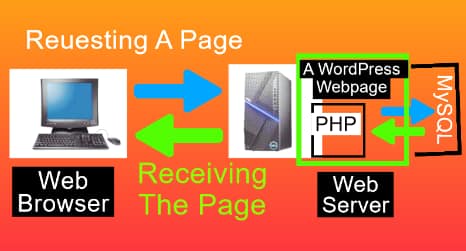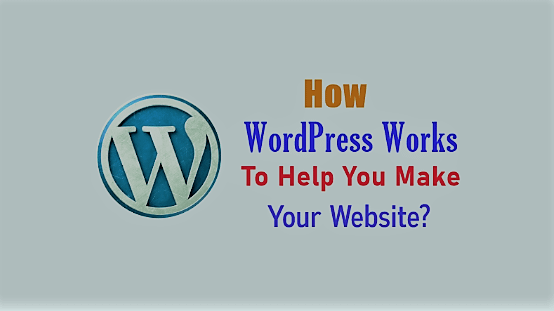Do you want to learn how WordPress works and why it is so popular and user friendly software that powers most of the websites on the internet today? If you do, continue scrolling down the page and read the post up to the last line.
WordPress is an open source software that web publishers and web developers use to build their sites. These sites include personal blogs and also the websites in various niches. Amazingly, this software powers 810 million websites as of April, 2023 according to colorlib website. This number is almost 43% of all websites on the internet. Also, this software has a share of over 64% of all content management systems (CMS) in the market.
The good thing about this software is that any body can use it for free for building and publishing their blog and website. Also, this software is very much user friendly. And that is the reason it has the recognition of being the gold standard for the site owners – the businesses, bloggers and publishers.
Page Contents …
What Is WordPress?
WordPress is a platform you can use to create your blog or website. When you use this software, you simply write the contents of your blog or website into its codes and publish it on the internet. In the process, you don’t do any thing to change, modify or write a code.
Diving into the differences between the blogs and websites are out of the scope of this update. So, I will not describe what the blogs and websites are and what are the differences between them.
As I mentioned above, you directly input the contents into the codes, you don’t need to learn coding or programming to publish your ideas on the world wide web. The software is available for anyone without paying any price.
This is what a non geek is expected to know about WordPress.
However, for a geek, the WordPress is a content management system. That means, it is a software used to create, edit and publish the contents on the internet. It has been written in PHP language. The platform uses MySQL data base to store all data related to the website and the blog.
Since this software is available for free, and it’s flexible enough to build any type of websites from simple blogs to sophisticated ecommerce sites and any thing else in between, it has become the most popular platform to create and publish the content on the internet.
How WordPress Works?
After having a general introduction of WordPress, you may be excited to know how it works. The first thing that comes to mind from the above introduction is that the WP is a web page builder. However, that is not true.

A web page building involves just knowing HTML and CSS. The HTML (Hypertext Mark up Language) is the language, the web programmers use to write web pages. And the CSS (Cascading Style Sheets) is the language they use to format web pages to provide them the desired look.
A web programmer can use HTML and CSS on a web page editor and create web pages. However, the web pages created this way form a static web site only.
As regards WordPress, it is more than that. Instead of creating web pages, this software helps you to input your data into the codes. This data includes the text, images, sounds, videos and the animations that you want to include in your blog posts. You, also, include these data in the articles, product catalogues and the other webpages of a website. When published, these data are available to the visitors of your web site.
As soon as a visitor clicks a link to go to a web page on your website, the WordPress assembles the data pertaining to that web page and delivers the page on his or her computer’s screen.
The visitor of your website browses it in several ways. While doing so, he or she may look for the content in a particular category, the date-wise info, the author-wise blog posts and so on. The interactivity features of WordPress deliver the content to your visitors on your website the way they want.
Thus, the WordPress provides a dynamic environment. This is how this software is different from static web page builders.
How WordPress Works Under The Hood?
The following paragraphs explain how the WordPress works under the hood.
I start explaining the work of WordPress with the general introduction of some terms. So, let me talk about the first thing first. And that first thing is the WordPress site – a blog or website.
A WordPress site sits on a server. A server is a very high powered computer. It runs your website and several other people’s website as well. When a website visitor visits a website, his or her web browser sends a request for a webpage to the web server hosting your website. The web server, then, sends the webpage to the web browser that has requested the web page.
A question may arise in your mind that how does the web server send the page to the web browser?
As in Figure 2 below, there are two players that play their very important roles. Then it becomes possible for WordPress sitting on the server to work. Or, in other words, WordPress performs it’s tasks when the other two players play their roles.
These players are as follows:

- A Database and
- A Programming Code
WordPress uses MySQL database. It houses itself on the web server. The database is the storage system for websites. Obviously, it stores all the contents of the websites’ pages. These page contents include the category and tags for the pages. Also, the page contents include the comments the visitors have left on the pages.
A programming code, the PHP, comes into action when a website visitor sends a page request on a WordPress website. The code then pulls the information from different parts of MySQL database. After that it assembles the information to make the webpage. Subsequently, the WordPress sitting on the web server delivers the webpage to the web browser of the website visitor. All this happens in as little time as the blink of your eyes.
Themes, Plugins And Widgets
The WordPress is a flexible software that allows you to add themes and plugins to it. Adding themes and plugins enables several extra features and functionalities to your website. Whereas the WordPress themes provide the design framework for your website, the WordPress plugins add functionality to it.
By default, this software comes with several widgets including categories, tag cloud, navigation menu, calendar, search bar, recent posts, and more. However, the plugins also add their own widgets which you can use to add plugin functionality to different sections.
Most of the themes add widgets to the header, footer and sidebar areas of your website.
It is clear from the above that the WordPress provides the real estate for building and publishing any type of website and blog, from very simple to very complex ones, for any purpose in any niche.
From the facts I mentioned above, it is clear why WordPress is so popular.
You may be interested in knowing, overall, what are the features of WordPress that you use to build a website that looks the way you want and serves the purpose you built it for.
In fact, WordPress has all the features you may need to build and publish any type of website or blog in any niche.
This website, the pkailash.com, is using this platform to house itself to publish contents that will serve as the resources for any one who wants to start a blog.
The About page of this website mentions how this website came into being to publish blogging resources on a WordPress website.
My WordPress: Surprisingly It’s Very Easy To Learn, a previous post on WordPress, makes a mention of how I, the author of this post and founder of this website, chose WordPress to create content of this website and publish it on the internet.
This is all about how WordPress works and how its flexibility features allow the users to blogs and websites in any niche.

Your Feedback Here